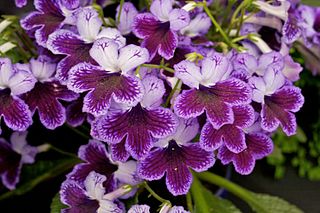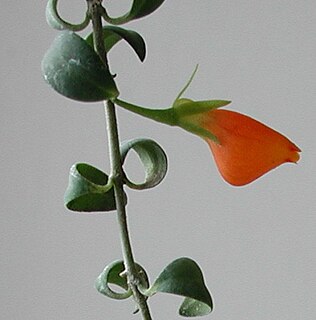Related Research Articles

Gesneriaceae, the gesneriad family, is a family of flowering plants consisting of about 152 genera and ca. 3,540 species in the tropics and subtropics of the Old World and the New World, with a very small number extending to temperate areas. Many species have colorful and showy flowers and are cultivated as ornamental plants.
Lamb or The Lamb may refer to:

The Marie Selby Botanical Gardens is a 15-acre (6.1 ha) botanical garden located at 900 South Palm Avenue in Sarasota, Florida. The Gardens are located on the grounds of the former home of Marie and William Selby.
The Regeneron International Science and Engineering Fair (ISEF) is an annual science fair in the United States. It is owned and administered by the Society for Science, a 501(c)(3) non-profit organization based in Washington, D.C. Each May, more than 1500 students from roughly 70 countries and territories compete in the fair for scholarships, tuition grants, internships, scientific field trips and the grand prizes, including one $75,000 and two $50,000 college scholarships. All prizes together amount to over $4,070,000. Two awards ceremonies are held including: Special Awards Organization Presentation and the Grand Awards Ceremony. The International Science and Engineering Fair was founded in 1950 by Science Service and was sponsored by the Intel Corporation from 1997 to 2019. Since 2020, Regeneron Pharmaceuticals is the title sponsor for ISEF, but the event that year was cancelled and replaced with an online version due to the COVID-19 pandemic.

Gloxinia is a genus containing three species of tropical rhizomatous herbs in the flowering plant family Gesneriaceae. The species are primarily found in the Andes of South America, but Gloxinia perennis is also found in Central America and the West Indies, where it has probably escaped from cultivation.

A popular house plant, Streptocarpus, is an Afrotropical genus of flowering plants in the family Gesneriaceae. The genus is native to Afromontane biotopes from central, eastern and southern Africa, including Madagascar and the Comoro Islands. The flowers are five-petalled, salverform tubes, almost orchid-like in appearance, and hover or arch over the plant, while the pointed, elongate fruit is of a helical form similar to that of the "tusk" of a narwhal. In the wild, species can be found growing on shaded rocky hillsides or cliffs, on the ground, in rock crevices, and almost anywhere the seed can germinate and grow. For the home, there are now many hybrids of various colours and forms available.
The Society of Biblical Literature (SBL), founded in 1880 as the Society of Biblical Literature and Exegesis, is an American-based learned society dedicated to the academic study of the Bible and related ancient literature. Its current stated mission is to "foster biblical scholarship". Membership is open to the public and consists of over 8,300 individuals from over 100 countries. As a scholarly organization, SBL has been a constituent society of the American Council of Learned Societies since 1929.

Incarvillea is a genus of about 16 species of flowering plants in the family Bignoniaceae, native to central and eastern Asia, with most of the species growing at high altitudes in the Himalaya and Tibet. The most familiar species is Incarvillea delavayi, a garden plant commonly known as hardy gloxinia or Chinese trumpet flower. Unlike most other members of Bignoniaceae, which are mainly tropical woody plants, species of Incarvillea are herbaceous perennial plants from temperate regions.

Seemannia is a New World genus in the flowering plant family Gesneriaceae. There are four species in the genus, primarily found in the Andean regions of South America. The name honors the German botanist Berthold Carl Seemann.

Sinningia is a genus of flowering plants in the family Gesneriaceae. It is named after Wilhelm Sinning (1792–1874), a gardener of the Botanische Gärten der Friedrich-Wilhelms-Universität Bonn. There are about 65 species of tuberous herbaceous perennials, all occurring in Central and South America, with the greatest concentration of species occurring in southern Brazil.
The American Institute of Mining, Metallurgical, and Petroleum Engineers (AIME) is a professional association for mining and metallurgy, with over 145,000 members. It was founded in 1871 by 22 mining engineers in Wilkes-Barre, Pennsylvania, United States, being one of the first national engineering societies in the country. Its charter is to "advance and disseminate, through the programs of the Member Societies, knowledge of engineering and the arts and sciences involved in the production and use of minerals, metals, energy sources and materials for the benefit of humankind."

Nematanthus is a genus of flowering plants in the family Gesneriaceae. All of its species are endemic to Brazil. Compared to other gesneriads, Nematanthus has leaves that are small, succulent, and hard-surfaced. The plant has a trailing, branching, and spreading habit; it is generally an epiphyte in nature and a hanging-basket plant in cultivation. The flower has fused petals. In some species, the flower has a "pouch" at the bottom. The fancied resemblance of such flowers to a goldfish gives these plants the common name "goldfish plant" or "guppy plant".
Benjamin Peter Gloxin (1765–1794) was a German physician and botanical writer who lived in Colmar. He is commemorated by the Brazilian genus Gloxinia and Sinningia speciosa, which is commonly called Gloxinia in the horticulture trade. In 1791, he was elected to the American Philosophical Society.
Harold Emery Moore, Jr. was an American botanist especially known for his work on the systematics of the palm family. He served as Director of the L. H. Bailey Hortorium at Cornell University, and was appointed Liberty Hyde Bailey Professor of Botany in 1978. He was an important contributor to Hortus Third and was founding editor of the palm journal Principes. He also edited Gentes Herbarum and provided the foundation for the first edition of Genera Palmarum, a seminal work on palm taxonomy which was later completed by Natalie Uhl and John Dransfield.
John Dransfield is an honorary research fellow and former head of palm research at the Royal Botanic Gardens, Kew, United Kingdom, as well as being an authority on the phylogenetic classification of palms.
The Society of Chemical Industry or SCI America is an independent learned society inspired by the creation of the Society of Chemical Industry (SCI) in London in 1881. Originally known as the New York Section, it was formed in 1894 and officially renamed the America Section in 1919. The main activity of the America Section is the awarding of several prizes in chemistry: the Perkin Medal, the Chemical Industry Medal and the Gordon E. Moore Medal. The America Section also works with the American Chemical Society (ACS) and others to support scholars in chemistry and chemical engineering.

Episcia cupreata is a species of perennial plant in the family Gesneriaceae that is found in Brazil, Colombia, and Venezuela. Its common name is flame violet, although this name may also refer to other species of the genus Episcia. A number of hybrids have been created.
Smithiantha zebrina is the first Smithiantha species that was used for horticulture. It has red and yellow spotted flowers and dark green leaves. The species is native to eastern Mexico. The stems are 75 cm tall, the leaves are 125–180 mm (5–7 in) long, and the flowers are 30–40 mm long.

Codonanthopsis is a genus of flowering plants in the family Gesneriaceae. Its native range is from southern Mexico through tropical America to Bolivia and most of Brazil. Codonanthopsis species are generally trailing epiphytes with pale flowers. Most have a mutualistic relationship with tree-living ants: the plants provide the ants with food, including nectar, and give their nests structure and support, while the ants disperse the plants' seeds. The genus was considerably expanded in 2013 when species were transferred from Codonanthe. Some Codonanthopsis species are cultivated as houseplants, when they may be grown in hanging baskets.
Genera Palmarum is a botany reference book that gives a detailed overview of the systematic biology of the palm family (Arecaceae). The first edition of Genera Palmarum was published in 1987. The second edition was published in 2008, with a reprint published in 2014. Genera Palmarum is currently the most detailed monograph on palm taxonomy and systematics.
References
- ↑ ICRA Report Sheet Gesneriad Society, retrieved November 25, 2014.
- ↑ Balick, Michael J. (1980). "Harold E. Moore, Jr. (1917–1980): A tribute". Brittonia. 32 (4): 494. doi:10.1007/BF02807139.